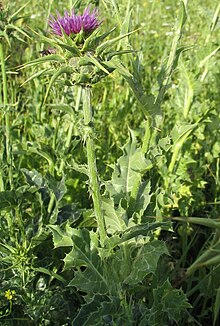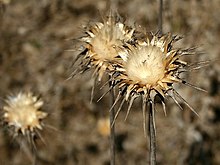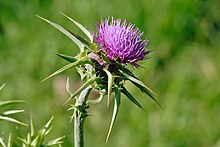Silybum
| Milk thistle | |
|---|---|

| |
| Silybum marianum | |
| Scientific classification | |
| Kingdom: | Plantae |
| Clade: | Tracheophytes |
| Clade: | Angiosperms |
| Clade: | Eudicots |
| Clade: | Asterids |
| Order: | Asterales |
| Family: | Asteraceae |
| Subfamily: | Carduoideae |
| Tribe: | Cardueae |
| Subtribe: | Carduinae |
| Genus: | Silybum Adans. |
| Type species | |
| Carduus marianus[1] | |
| Species | |
| Synonyms[2] | |
| |
Silybum (milk thistle) is a genus of two species of thistles in the family Asteraceae.[1][3] The plants are native to the Mediterranean regions of Europe,[4] North Africa, and the Middle East. One species has been introduced elsewhere, including in North America.[5] The name "milk thistle" derives from a feature of the leaves, which are prominently banded with splashes of white. Historically, these milky bands were said to be Mother Mary's milk, and this is the origin of another common name, St. Mary's thistle. The most widespread species is Silybum marianum.[6]
Claims have been made since ancient times[when?][where?] that the active flavanoid-lignan (flavanolignan) group of constituents, called silymarin, contained only in the seed shell has liver-protective and regenerative properties, as well as antioxidant effects. Chemical, pharmacological, and safety research started in Germany in the 1950s[citation needed].
Description and classification
[edit]
Members of this genus grow as annual or biennial plants. The erect stem is tall, branched and furrowed but not spiny. The large, alternate leaves are waxy-lobed, toothed and thorny, as in other genera of thistle. The lower leaves are sessile (attached to the stem without petiole). The upper leaves have a clasping base. They have large, disc-shaped pink-to-purple, rarely white, solitary flower heads at the end of the stem. The flowers consist of tubular florets. The phyllaries under the flowers occur in many rows, with the outer row with spine-tipped lobes and apical spines. The fruit is a black achene with a white pappus.[7]
- Silybum eburneum Coss. & Dur., known as the silver milk thistle, elephant thistle, or ivory thistle - Algeria, Morocco, Tunisia, Spain
- Silybum eburneum Coss. & Dur. var. hispanicum
- Silybum marianum (L.) Gaertner, the blessed milk thistle, which has a large number of other common names, such as variegated thistle. - widespread across much of Europe, Asia, and North Africa from Norway and the Canary Islands to China and Maluku; naturalized in Australia, New Zealand, and the Americas
The two species hybridise naturally, the hybrid being known as Silybum × gonzaloi Cantó, Sánchez Mata & Rivas Mart. (S. eburneum var. hispanicum x S. marianum)
- formerly included[8]
- Silybum atriplicifolium - Synurus deltoides
- Silybum cernuum - Alfredia cernua
Silybum marianum is by far the more widely known species. Milk thistle is believed to give some remedy for liver diseases (e.g. viral hepatitis) and the extract, silymarin, is used in medicine. Mild gastrointestinal distress is the most common adverse event reported for milk thistle. The incidence is the same as for placebo.[10] A laxative effect for milk thistle has also been reported infrequently.[11]
Claims of health benefits
[edit]
For many centuries extracts of milk thistle have been recognized as "liver tonics."[12] Milk thistle has been reported to have protective effects on the liver and to greatly improve its function. It is typically used to treat liver cirrhosis, chronic hepatitis (liver inflammation), toxin-induced liver damage including the prevention of severe liver damage from Amanita phalloides ('death cap' mushroom poisoning), and gallbladder disorders.[11][13]
Reviews of the literature covering clinical studies of silymarin vary in their conclusions.
See also
[edit]- Cnicus (Blessed thistle)
- Silybum marianum (Blessed milk thistle)
References
[edit]- ^ a b Tropicos, Silybum Vaill.
- ^ Tropicos search for Silybum
- ^ Vaillant, Sébastien. 1754. Der Konigl. Akademie der Wissenschaften in Paris Physische Abhandlungen 5: 173, 605
- ^ "Herbs At A Glance – Milk Thistle". National Center for Complementary and Integrative Health. Retrieved 2 December 2012.
- ^ "Silybum in Flora of North America @". Efloras.org. Retrieved 2022-05-01.
- ^ Altervista Flora Italiana, Cardo mariano, Blessed Milkthistle, Variegated Thistle, silybe de Marie, Mariendistel, Silybum marianum (L.) Gaertn. includes photos and distribution maps
- ^ Flora of North America, Vol. 19, 20 and 21 Page 164, Blessed milkthistle, Silybum marianum (Linnaeus) Gaertner, Fruct. Sem. Pl. 2: 378. 1791.
- ^ a b Flann, C (ed) 2009+ Global Compositae Checklist Archived 2015-01-15 at archive.today
- ^ The Plant List search for Silybum
- ^ Rainone, F (2005). "Milk thistle". American Family Physician. 72 (7): 1285–1288. PMID 16225032.
- ^ a b Greenlee, H; Abascal, K; Yarnel, E; Ladas, E (2007). "Clinical applications of Silybum marianum in oncology". Integrative Cancer Therapies. 6 (2): 158–165. doi:10.1177/1534735407301727. PMID 17548794.
- ^ Gazák R, Walterová D, Kren V (2007). "Silybin and silymarin—new and emerging applications in medicine". Curr. Med. Chem. 14 (3): 315–38. doi:10.2174/092986707779941159. PMID 17305535.
- ^ Tamayo, C; Diamond, S (2007). "Review of clinical trials evaluating safety and efficacy of milk thistle (Silybum marianum [L.] Gaertn.)". Integrative Cancer Therapies. 6 (2): 146–157. doi:10.1177/1534735407301942. PMID 17548793.
External links
[edit]![]() Media related to Silybum at Wikimedia Commons
Media related to Silybum at Wikimedia Commons
